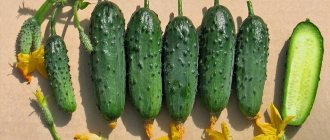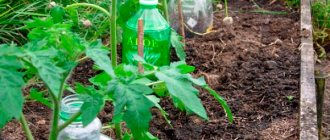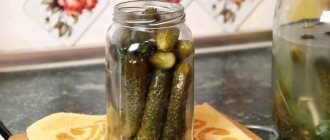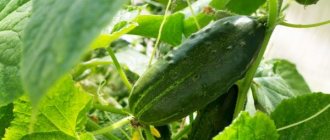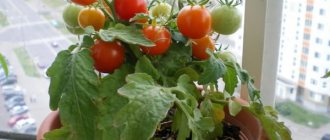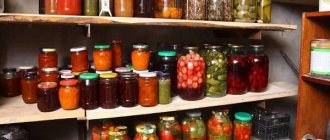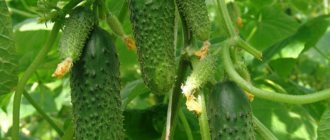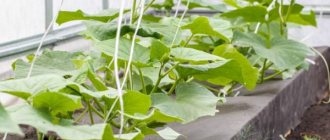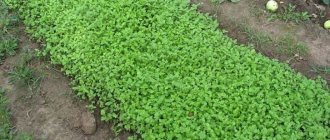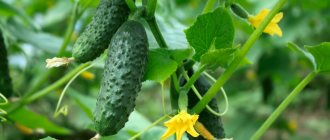Vegetable growing » Cucumbers
0
3190
Article rating
Kira Stoletova
Everyone wants to enjoy delicious, juicy cucumbers grown in their own garden. But what to do if there is no land? Breeders came up with a way out of the situation and created varieties of cucumbers for balconies or loggias. Let's consider which varieties are suitable for growing on the balcony.
Popular varieties of cucumbers for balconies
Is it possible to grow cucumbers on the balcony?
Anyone who has ever seen cucumbers growing on someone’s windowsill will not be surprised to notice that behind the glass railings of balconies and loggias there are green vines with large leaves and hanging elongated pimply fruits. Unfortunately, not all vegetable growers who grow cucumbers on the balcony achieve the long-awaited result.
Many people lack knowledge about all the intricacies of working with seedlings, about creating the necessary microclimate, about preparing the soil and planting containers, about varieties and hybrids that are suitable for balcony production conditions.
But those who have familiarized themselves with the recommendations and experience of experts in the step-by-step cultivation of cucumbers in cramped apartment conditions, without much effort manage not only to feed fresh cucumber salad to their household, but also to preserve a considerable amount of their favorite vegetable grown on their own balcony. (Recipes “What can be prepared from cucumbers” HERE)
Variety "City cucumber"
Photo: City cucumber
Hybrid, which is cultivated on a loggia or in an apartment.
Peculiarities:
- bunched gherkin;
- internodes are short;
- small sheets;
- increased shade tolerance;
- begins to bear fruit at 39-41 days;
- develops 4-10 ovaries;
- fruits are 10-13 cm long, weighing 70-95 grams.
Cucumber is very tasty fresh. Zelentsy are well suited for canning. Vegetables can be grown in an open garden bed or under a film cover. Viable and unpretentious.
How to grow cucumbers on the balcony
For beginning balcony gardeners, before planting seeds for cucumber seedlings, it is important to make sure that they can create the necessary microclimate and provide regular care for the plantings.
A balcony or loggia that is not glazed will not allow you to maintain the required optimal temperature and humidity. The location of balcony windows strictly north or south will require the use of additional lighting or shading. The ceilings on the balcony must be suitable for installing structures to which twine will have to be attached for tying cucumber vines.
You will need spacious growing containers that can hold at least 5 kg of soil and have drainage holes.
It is necessary to foresee in advance the possibility of a long absence of owners, and consider options for autonomous watering of plants. The purchase of an indoor automatic irrigation watering system entails additional financial investments, but an agreement with a neighbor to look after a balcony garden threatens with stories on the bench near the entrance about what she will see in someone else’s apartment.
After all these issues are resolved positively, you can begin the first steps of growing cucumbers on the balcony.
When can cucumbers be planted?
The time for planting cucumbers will depend on the created microclimate. First of all, and equally, three indicators are taken into account: air temperature and humidity and the optimal length of daylight hours. If conditions are maintained artificially, then growing seedlings can begin immediately after disinfection and germination of the selected seed material and preparation of planting pots and soil.
If it is impossible to maintain sufficiently bright lighting for 12-14 hours, the indoor air temperature is at least 18-20°C, and the humidity is from 80 to 90%, it is better to postpone the first stage of working with cucumbers on the balcony.
It is worth waiting for the natural optimal atmospheric conditions to arise from mid-April to the first days of May. But in any case, the need for periodic illumination in dense clouds, irrigation in highly dry air and shading in the scorching sun will not disappear.
Varieties and hybrids of cucumbers suitable for growing on a balcony
Bitter disappointments accompanied the first experimenters who decided to start a garden with cucumbers on the balcony in the winter or spring months. At first, tested seeds for open ground and ventilated greenhouses were used for seedlings. But only occasionally, under the condition of very painstaking and constant work associated with artificial fertilization of female flower stalks, was the harvest volume intended by the breeders harvested from the bushes.
Then hybrids and varieties of cucumbers appeared, specially created for the limited capabilities of small enclosed spaces that do not allow pollinating insects inside.
It is also important that the characteristics of balcony cucumber species, in addition to self-pollination, resistance to low humidity and lack of light, provide for the formation of a strong root system, a long central stem with a small number of short side shoots and reduced leaves.
Cucumber seeds for growing on the balcony
On packs of seeds, manufacturers must indicate, in addition to the name, consumer properties, expiration dates, degree of processing and planting location. For growing cucumbers on window sills, balconies and loggias, shade-tolerant, early-ripening parthenocarpic gherkins are mainly recommended. These include:
- "Urban cucumber F1";
- "Balagan F1";
- "Balcony F1";
- "Hummingbird F1";
- "Swallowtail F1";
- "F1 debut";
- “Granddaughter F1” and many others.
Cucumber seeds for growing on the balcony
Hummingbird
Cucumbers "Hummingbird"
Self-pollinating gherkin hybrid. The shoots on the sides are small.
- The plant begins to bear fruit 38-42 days after planting the seeds.
- The internodes are shortened, 3-10 ovaries are formed in each.
- The variety is shade-tolerant. Resistant to diseases.
- The leaves of the plant are not large.
- The fruits resemble a cylinder. The peel has small tubercles and white spines.
- Vegetables do not overgrow.
The cucumber is perfect for growing on a loggia or windowsill.
Growing cucumbers on the balcony step by step
After the first step towards a harvest of cucumbers on the balcony, which consisted of creating optimal atmospheric conditions and choosing planting material, you need to decide whether the seeds should be disinfected and stimulate growth, and then decide which planting method to use - through seedlings or sowing seeds in a permanent place in a container for growing.
How to choose quality seeds for cucumber seedlings
We identify seeds that have lost their germination: we pour them into a container with water, shake the water and wait until it becomes motionless; damaged and dried seeds remain on the surface of the water, they must be removed. Then we drain the water and carry out procedures with the remaining seeds to ensure resistance to pests and diseases.
To do this, we use either folk remedies (for example, soak in a pink solution of potassium permanganate for 20 minutes), which actually remove the infection only from the surface of the seeds, or we use modern fungicides and biological products according to the manufacturer’s instructions, or we skip this step if the manufacturer provided information on the packets of seeds about seed treatment.
It is better to germinate cucumber seeds by allowing sprouts to emerge from the seed pod to a length of no more than 0.5 cm.
If the seeds are dressed in a multi-colored glaze with the addition of the necessary microelements and disinfectants, we plant them in moist soil in the form in which the manufacturer poured them into the packaging.
Selection of containers and soil for seedlings
In urban conditions, it is best to purchase a ready-made soil mixture specifically designed for growing pumpkin crops, which include cucumber, or a universal one with normal acidity. In addition, you will need drainage material - fine expanded clay, vermiculite, purchased ready-made, or homemade from polystyrene foam, sunflower or buckwheat husks, crushed hard parts of walnuts.
When choosing a container for cucumber seedlings, they most often choose individual plastic transparent cups with a capacity of 100-150 ml; their use allows you to control the development of the plant’s root system. The roots of the plant should be white; areas of gray or black indicate that the plant is waterlogged and rotting. It is possible to grow together in plastic cassettes with the same cell volume. Containers must have holes for water drainage. Drainage is poured into the bottom of the cups, soil mixture is placed on top, filled to 2/3 of the height.
Seeds are sown to a depth of 1-2 cm in moist soil. A hole is first made in the soil and the seeds are placed flat. Transparent bags are placed on top of the glasses and tied at the bottom; a piece of glass is placed on the cassette, that is, mini greenhouse conditions are created. Once a day, the bags and glass are removed for 20-30 minutes, and the soil is moistened if necessary. It is better for containers with ungerminated seeds to be kept in a dark and warm (25°C) place. With the appearance of the first arcs of sprouts, this usually happens on days 5-7, the cups or cassette are opened and moved to the light.
During the first three days, during the lighting stage, the temperature is maintained within 20°C, at night - 16°C. For constant cultivation, daytime temperature should not exceed 22°C, night temperature =18°C.
As the plants grow, add soil to the glasses or cassette and make sure that the seedlings do not become thin or stretched out. Daily monitoring of soil and air humidity and artificial lighting are necessary. The length of the day should be at least 16-18 hours in the first week after germination, then 12-14.
Transplanting seedlings and growing in plastic bottles
When two or three true leaves appear on cucumber seedlings, they begin to prepare containers for permanent cultivation of plants from plastic bottles with a volume of 5 to 10 liters. Fill half the volume with the same soil and drainage. The soil is compacted and moistened. If no holes are made in the bottom of the bottles, then the drainage layer must be significant.
The containers can not be shortened along the entire circumference, but only in the upper part, openings can be cut for the stems. In the latter case, it will be convenient to tie the cord not to the bottom of the cucumber stem, but to the top of the bottle. The stems of an adult plant will curl along it.
It is not advisable to replant overgrown (over one month old) cucumber seedlings. When transferring plants into large containers, try not to damage the root system and not to bury the central stem into the soil. To do this, the soil under the seedlings is not heavily moistened so that the lump of earth can keep its shape and not crumble when touched, and after transplanting the soil is well watered using some kind of rooting agent.
Seedling care
Seedlings grow in about 3-4 weeks.
During this period, it is recommended to feed her twice:
- The first fertilizing can be done 1.5-2 weeks from the date of emergence. This will require 1 teaspoon of urea per 3 liters of water. One cucumber planted in a balcony container requires at least 1 cup of fertilizer.
- The second feeding is carried out after another 1-1.5 weeks. Fertilizer consumption is the same.
Adult seedlings are transplanted into large containers with a side height of at least 15 cm. Before this, the soil should be generously moistened with water at a temperature of about +30°C. The seedlings are carefully dug up and moved to a new container with a lump of earth.
Caring for cucumbers on the balcony in summer
It is allowed to move the cucumber to grow on a glassed-in balcony no earlier than the risk of night frosts has passed. As a rule, by this moment the bushes reach such a height that they begin to bow to the ground under their own weight. Therefore, under the cucumber on the balcony container, a structure is installed to support and weave the vines.
For this:
- They stretch a clothesline right up to the ceiling.
- Small pegs are driven into the containers at a distance of about 10 cm from the seedlings.
- A twine is pulled between the rope and the pegs, to which the cucumber growing on the balcony will cling.
The cucumber produces many tendrils that wrap around the balcony twine. So the plant begins to quickly “crawl” upward. Thanks to this support, it is more convenient to care for the bush and it is easier to harvest.
Further care consists of daily watering, spraying and shading from the bright midday sun. There is no need to pinch a cucumber growing on a balcony as long as it has room to grow along the support.
If the experiment in growing vegetables is a success, and the cucumber continues to bear fruit on the balcony in August, the containers in which they grow should be insulated. It's approaching autumn, and at night in the last month of summer the temperature drops noticeably. Burlap, spunbond or any other suitable material is used as insulation.
It is allowed to move a cucumber to grow on a glazed balcony no earlier than the risk of night frosts has passed
Growing a cucumber on your own balcony is not so difficult. It’s quite easy to set up a place for vegetables, but otherwise you just need to follow the instructions on the package, monitor the temperature and don’t forget about watering. This approach will provide the family with fresh vegetables all summer long.
How to grow cucumbers on the balcony in winter
If the balcony has reliable insulation, artificial lighting and sufficient heating, then winter cultivation in plastic bottles has the same algorithm as at other times of the year. It may be necessary to spray the leaves of an adult plant only less often, because the humidity level in winter is already high. But more often it is necessary to examine plants for diseases and rot, and, if necessary, apply means of protection against them.
Debut
Variety Debut
Hybrid is self-pollinating, early ripening, producing high yields, with female type flowers. Used fresh. The greens are shaped like a cylinder. There are tubercles on the surface of the peel. The fruits are 12-14 cm long, weighing up to 100 grams. Gardeners love cucumbers for their excellent taste. Not suitable for canning.
The plant is low with a bunched ovary. The shoots on the sides grow quickly, but are not long. The variety is resistant to diseases and does not require special additional care.
Retains all properties when grown in beds and in a greenhouse.
How to get a big harvest at home
Feeding cucumbers
The first feeding is necessary at the seedling stage. It is carried out when the second true leaf appears. Use complex water-soluble fertilizers containing microelements, nitrogen, potassium and phosphorus according to the manufacturer's instructions.
The following feedings are carried out once every 2 weeks. At different stages of plant development, fertilizer compositions are selected that are appropriate to the age of the bush.
During the period of elongation and growth of the green mass of stems and leaves, nitrogen and phosphorus should predominate; when the fruits ripen, the emphasis is on potassium-phosphate fertilizers.
After the first harvest is harvested, they return to nitrogen-phosphorus-potassium fertilizers. Feeding can be root feeding, while watering the plants, and so-called leaf feeding, while spraying water over the bush.
Bush formation
The most difficult task for beginners who like to grow cucumbers on a balcony or on a windowsill is always timely inspection of cucumber bushes. It is necessary to remove unnecessary shoots, tendrils and ovaries, then the cucumbers left on the bush will receive the necessary substances and moisture in full.
The bushes should not be thickened. When growing on a balcony, the plant is left with one central stem and one ovary in the leaf axils. All side shoots up to a height of the main vine of 50 cm are removed. Then you can leave another stem and tie the plant with two strands of jute twine, spaced at least 40 cm apart.
It is important to consider that it is not the rope that is wrapped around the cucumber stems, but vice versa. You can attach the twine to a reusable plastic garter attached to the first leaf from the root. It is securely attached with the help of blunt notches along its surface, and at the same time, the tightness of contact with the plant is adjusted at the discretion of the gardener.
Soil care
The soil in bottles or jars with cucumber bushes should not dry out. A single watering of young plants is carried out in the morning.
During fruiting, double watering (morning and evening) is necessary, because fruit filling occurs at night.
Over time, the soil compacts and settles; if necessary, the volume of soil is gradually increased, carefully pouring it into containers for growing cucumbers up to the very edges. Do not allow a crust to appear on the ground above the roots of the cucumbers. Loosening is carried out regularly, but very carefully, trying not to damage the plant.
When the first cucumbers reach the required size, making them suitable for consumption, there is no need to delay removing them from the bushes. Balcony plants have little strength, so let them better give it to the remaining ovaries. In order to improve the condition of adult cucumber plants on the balcony, you can carefully transplant them into buckets or other growing containers with a larger volume than before.
Garland
variety "Garland"
Hybrid. Amazing variety. When they ripen, there are so many greens that the plant resembles a Christmas tree with garlands. The variety amazes with rich harvests.
Shade-tolerant bush. The flowers are female and self-pollinating. The fruits are medium-sized from 13-17 cm, weighing up to 125 grams.
Cucumbers have excellent taste. Vegetables are suitable for fresh consumption. Salted and pickled cucumbers are also good.
There are a lot of cucumber varieties bred by breeders for balconies and apartments.
Note! Seeds of green hybrids do not germinate. Planting material will have to be purchased from the store annually.
Cucumbers on the balcony (video)
How the owner treats his pets will determine the size of the harvest and the joy of the household when they see fresh, hand-grown cucumbers on the table.
As you can see, you can harvest cucumbers on your own balcony or windowsill! Vitamins all year round! Well, it’s up to you to decide what to cook from cucumbers! You can read the best recipes for dishes made from cucumbers in the article “What can be prepared from cucumbers” .
Health to you and your loved ones! Natalya Belokopytova.
Zozulya
Variety “Zozulya” for the balcony
Cucumber has long been known and very popular among summer residents and amateur gardeners. The plant is small, not spreading. The bush is resilient and immune to disease.
The fruits are cylindrical in shape, with tubercles and not too noticeable thorns on the peel. Cucumbers are 20-22 cm long, weight - 220 grams.
The vegetable is famous for its taste. The pulp is juicy, fragrant, sweetish. There is no bitterness.
Cucumber gives a decent harvest when planted under film. In an open garden, the harvest is weaker than in a greenhouse.
Advantages and disadvantages
The Balcony f1 cucumber variety is famous for a number of positive characteristics:
- high yield (among varieties for home cultivation);
- compact bush size;
- cucumbers do not grow in length;
- no tendency to barrel fruit;
- taste without bitterness, sweetish, not herbaceous;
- precocity;
- self-pollinating;
- easy to care for;
- shade-tolerant;
- resistant to diseases and pests;
- The fruits are good for both fresh consumption and canning.
According to reviews from growers, Balcony f1 has no significant shortcomings.
Planting soil
One of the important conditions for a good harvest is the composition of the soil and its quality. You can't go wrong if you use a mixture of vermiculite and peat to prepare the soil.
The following composition of planting material is also popular: taken in equal quantities:
- peat,
- turf,
- humus (fat);
- small sawdust.
Table nitrophoska and urea are added to the resulting component mixture in the ratio: 1 bucket: 1 tbsp. l: 1 tsp. It also doesn’t hurt to sprinkle an additional 50 g of potassium, nitrogen or phosphorus fertilizers and ash into the mixture.
Preparing the site
To grow cucumbers, they usually use the simplest containers for balcony flowers.
They are compact and space saving. Containers can be conveniently positioned, taking into account a wide dimensional grid (from 150 mm in width to 850 mm in length). The place intended for seedlings has its own characteristics. Let's highlight the most important ones:
- drainage holes necessary to remove excess moisture. This is extremely important, as it prevents rotting of the rhizomes;
- stand where excess moisture is collected. They are installed under containers.
The drainage layer is laid out from expanded clay or small fractions of crushed crushed stone. Special mixtures that can be purchased at specialized flower shops are also suitable. They also sell ready-to-use soil saturated with minerals. You can also use land from a suburban area.
Sometimes five-liter plastic bottles are used for growing cucumbers. They are cut and holes are made in them. To protect seedlings from all kinds of pathogenic bacteria, containers should be disinfected. For example, hold them over steam from a boiling pan.
Transfer of shoots
Planting in permanent soil has a strict time frame: no earlier than a month after planting, but no later than one week after the last feeding. Before planting seedlings (about an hour), the soil mixture must be watered with hot water to sufficiently moisten the substrate.
The shoot is carefully removed from the cup. In order not to touch or injure the delicate rhizomes, it is replanted together with a lump of earth. Make a hole in the soil mixture, say, with a garden trowel, and place the young seedling in the hole.
For reference!
Seedlings in peat humus pots are planted along with the pot.
Description of varietal characteristics
A hybrid intended for cultivation at home was introduced in 2008. Large breeders, by crossing several varieties, have developed a cucumber that is unpretentious to growing conditions. A small amount of soil, lack of light, lack of insects - all this does not prevent the window-balcony plant from bearing fruit abundantly for a long time.
A feature of the variety is the average branching of the plant and shortened internodes. 6-8 ovaries are formed in one node, so the yield is high. From one compact bush it is possible to collect about 3 kg of fruit. There is a rapid increase in green mass, as well as a rapid entry into fruiting. In terms of ripening time, window-balcony trees belong to the group of early ripening varieties. The first greens appear on the bushes after 38-40 days. The fruiting period, subject to agricultural technology, is 60 days.
The fruits of the balcony are similar to the usual “street” gherkins. Cucumbers rarely grow more than 6 cm in length. The color is dark green, the shape is cylindrical. The surface is glossy with black spines. The pulp is juicy, crispy, and sweetish in taste. There are a lot of seeds inside the vegetables, but they are small. Pickles are most often used for food, but when planting 2-3 bushes it is possible to stock up on pickles. According to reviews from housewives, cucumbers do not lose their elasticity even during heat treatment.
On a note! The window-balcony hybrid f1 can be successfully grown in vegetable gardens in ordinary beds, as well as in greenhouse conditions. The yield from the bush will be lower than from varieties intended for personal plots. But advantages such as the compact size of the bush and moderate leafiness often outweigh these disadvantages.
Pest Prevention
Various insects also love conditions so favorable for the growth of cucumbers. To protect the crop, they resort to spraying the cucumber bush with special preparations or use folk remedies.
Fighting aphids
Tobacco decoction is very effective in combating aphids.
- They tear open 10 inexpensive cigarettes, pour the tobacco into a container filled with a liter of water and put everything on the fire. After boiling, the composition is boiled for about 10 minutes.
- Then the resulting decoction is diluted with another liter of water. The disinfectant is ready.
- The infusion is sprayed over the damaged leaves. Aphids sensitive to nicotine die.
Whitefly control
- Prevention can be carried out using a more concentrated tobacco decoction. It is prepared in the same way, but is additionally infused for 24 hours.
- Not everyone realizes that a vacuum cleaner with adjustable power will help to combat whiteflies quite effectively.
- Pests are collected from cucumber leaves with a vacuum cleaner operating in minimum power mode.
Fighting spider mites
All of the above methods will not help in the case of spider mites, but this parasite is afraid of garlic.
- A strong garlic infusion is prepared from a liter of water with the addition of a chopped head of garlic. The broth is left to steep for about 20 minutes, after which laundry soap diluted with water (about 15 g) is added to it.
- Next, the composition is diluted with water to obtain 5 liters of liquid.
- This is the disinfectant solution that is used to spray cucumber bushes.
Thus, you can deal with major pests without resorting to harmful chemicals.
